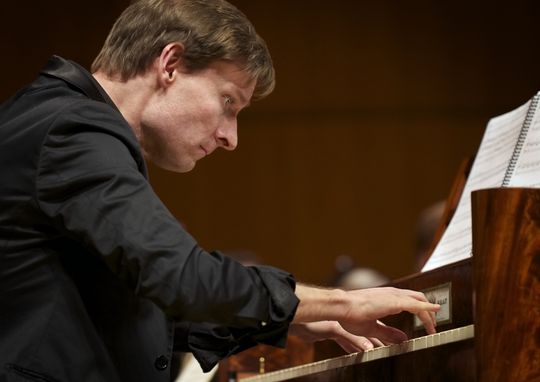Bezuidenhout displays rare artistry and insight with Freiburg Baroque Orchestra

Kristian Bezuidenhout directed and performed as soloist with the Freiburg Baroque Orchestra Saturday night at Alice Tully Hall. File photo: Klaus Rudolph
For many listeners, the greatest pleasure in historically informed performance is the sheer sound of the music. Gut strings, wooden flutes, and buzzing double reeds produce timbres and colors unheard in modern orchestras.
That was just one of the pleasures Saturday night in Alice Tully Hall, where the Freiburg Baroque Orchestra and fortepianist Kristian Bezuidenhout played a program of Haydn, Mozart, and Johann Christian Bach. One continually felt that the music, as performed, was as close as possible to what these composers heard in their heads when they were writing down notes.
That was due to the great musicality of all the players and in particular to director Bezuidenhout’s thoughtful musicianship. From the fortepiano, he shared conducting duties with concertmaster Anne Katherina Schreiber, and was also soloist in Mozart’s Piano Concerto’s Nos. 17 and 9.
The Freiburg Baroque Orchestra is one of the most stylish and versatile of early music ensemble. They have the usual agility and verve and with their often-throaty strings produce some of the most colorful sounds.
And so the opening of Haydn’s Symphony No. 74 was full of character. With little more than a dozen strings in total, the texture was far lighter than even a modern chamber orchestra can achieve, and the intimacy of the ensemble struck one as close to what one might have heard at the Esterhàzy court.
J.C. Bach’s Symphony in G minor, Op. 6, was something of a revelation. His symphonies are far less well known than those of his older brother, C.P.E., though those currently reside in a niche. The G minor Symphony is even more of a curiosity, the only such work that J.C. composed in a minor key.
From the Freiburg’s passionate playing, it sounded ultra-minor—there were the flatted thirds and sevenths, but the music also had a powerful and aggressive darkness. Our cultural ears are centuries past the point where the mere minor shakes us with sturm und drang, but Saturday night that feeling was real and thrilling.
Bezuidenhout’s series of fortepiano recordings on the Harmonia Mundi label have shown a unique closeness to Mozart. Saturday, his playing was thoughtful, dynamic, and sensitive in equal parts.
While the differences between early strings and woodwinds are mainly ones of timbre and volume, the gap between the early fortepiano and the modern version of the instrument is enormous. There are things a Steinway can do that Mozart would never have imagined, and so on the question of period authenticity, his keyboard music on the fortepiano is what he himself would have heard when he composed and played.
The fortepiano has nothing like the sustain and color of the modern instrument—there are no pedals—and has a percussive attack that is delicate but sharp. One imagines it is impossible to produce a true legato on it, but Bezuidenhout did, or created the illusion of it. Saying he placed one note after another with the right dynamics and micro-fractions of timing is correct but in no way explains how beautiful and deeply expressive his playing was.
This was at the fore in Mozart’s cadenzas where every surprising harmonic motion seemed to have a different color than other passages on this usually monochromatic instrument. The solo passages in the Andante of No. 17 were notably powerful, the quick decay of the notes making each sound almost lonely, producing a biting poignancy.
Doubling chords and baselines on the fortepiano in the symphonies, as he did, is a standard practice. Bezuidenhout also reinforced the ensemble in Mozart’s Concerto No. 17, picking a harmony here, a phrase there, well before the first notated piano entrance. This had a mild effect on the sound, but an exceptional one on the interpretation. There was no soloist, just an ensemble, interacting intimately with one instrument given consistent prominence.
Bezuidenhout played one encore, what he accurately described as a rarity, the Allemande movement from Mozart’s Suite in C Major, K. 399–quiet, mellifluous, and full of feeling. The orchestra members sat at the back of the stage, seemingly just as absorbed as the audience.
Posted May 21, 2018 at 11:34 am by Darrell
I was there and greatly agree with your assessment. One puzzlement for me was, why after the Haydn symphony, was the fortepiano repositioned, but, was not returned to the Haydn position for the Bach symphony?